With the exception of the Space Shuttle, the high altitude flights of the X-15 and SpaceshipOne, all other human spaceflights have used capsules for reentry followed by descent under parachute. The capsule approach was originally adopted as the quickest way to get humans into space, but even during the 1950s other approaches were being considered – designs that would allow returning spacecraft a greater deal of control during reentry and more accurate landings than the first generation capsules could offer.
One line of thought centred around a vehicle that could generate lift via the shape of its body alone, a ‘lifting body’, and one of the most effective of the configurations that followed was the Martin SV-5/X-24.
Initial steps toward lifting reentry
The lifting body story really begins with investigations to find the optimum survivable configuration for IRBM/ICBM warheads carried out by the National Advisory Committee for Aeronautics (NACA). It quickly became clear that the slender bullet-like shapes being considered for supersonic or even hypersonic atmospheric flight would not survive the intense heat of reentry into the atmosphere. In 1951 H. Julian Allen, an aerodynamicist at NACA’s Ames Aeronautical Laboratory, discovered that by using blunt nosed shapes a shock wave would be created ahead of the vehicle allowing much of the heat to dissipate and bringing the temperatures on the vehicle’s skin down to levels that could be handled by ablative heat shields.
Allen began working with Alfred J. Eggars to refine his ‘blunt body’ theory with regards to missile warheads and soon their work was adopted for the first generation of US ICBMs, but Eggars’ work led him to realise that by modifying the shape of the blunt body it would produce lift during reentry – a concept that became known as a lifting body. His designs began to focus on a half-cone shape which, with the addition of some small control surfaces would allow for controlled reentry and large lateral deviations from the original path, known as cross range. His initial design became known as the M1, but later this was refined into the M2 shape.
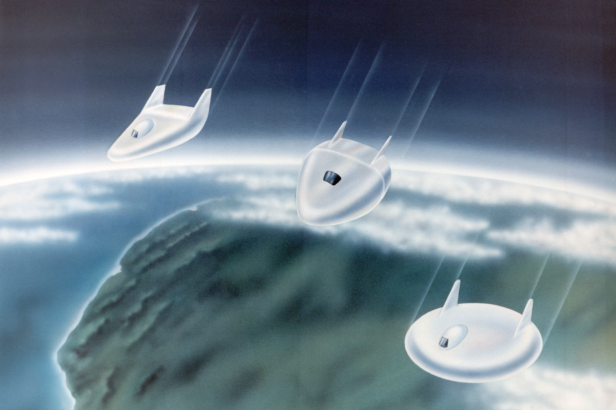
By 1960 the Air Force’s Space Systems Division (SSD) had issued research contracts for lifting body configurations based around Eggars’ M1 to the Martin Company. By 1961 SSD felt confident enough in the lifting body concept to include one as the crew vehicle of their ambitious LUNEX direct ascent lunar landing plan. SSD also proposed a direct competitor to Dyna Soar, SAINT II (a follow on from their earlier uncrewed SAtellite INTerceptor proposal). Carrying a crew of 2, SAINT II was to be a lifting body launched atop Martin’s Titan II missile and would carry out many of the proposed missions considered for Dyna Soar, most notably the interception and destruction of enemy satellites. Given the considerable investment already made into Dyna Soar, the Air Force cancelled SAINT II in 1961, but interest in lifting bodies continued.
Lifting bodies mature
By 1962 NASA engineer Dale Reed began to examine Eggars’ M2 lifting body design at the Flight Research Centre (FRC) at Edwards AFB. He initially built and flew small radio controlled models to establish the basic airworthiness of the shape. With this achieved he set about convincing his managers that a piloted prototype was the next logical step. What Reed and a small team including research pilot Milt Thompson came up with was a low cost, unpowered wooden vehicle named the M2-F1. Completed in 1963, the M2-F1 was initially tow tested behind a high powered Pontiac on the dry lakebed, but soon more ambitious flights were undertaken behind the FRCs C-47 with the vehicle proving challenging, but flyable.

”…an aerodynamic configuration capable of achieving at least 600 nautical miles cross range manoeuvring and capable of performing a tangential landing, and to develop an ablative heat shield material…capable of providing the configuration protection from the environment experienced in low earth orbits and in the return and reentry to tangential landings from these orbits”
The Air Force had already initiated the Spacecraft Technology and Advanced Reentry Test (START) programme for spaceplane relevant technologies, initially in support of Dyna Soar. Phase one of the programme was the small Aerothermodynamic Elastic Structural Systems Environmental Tests (ASSET) vehicle, a winged biconic device launched on a suborbital trajectory atop a Thor missile. ASSET’s main purpose was to better understand the thermal environment during a lifting reentry and to test out various heat shield materials. Six ASSET missions were flown between September 1963 and February 1965 and, with the exception of the second flight where the Thor malfunctioned, the tests were regarded as successful. By the end of 1963 Dyna Soar had been cancelled, but it was hoped that ASSET and future elements of the START programme could yield useful data for other space plane projects yet to come.
PRIME
In March 1965 USAF General Bernard A. Schriever announced the second element of START, the development of a manoeuvrable reentry vehicle under the Precision Recovery Including Manoeuvring Entry (PRIME) programme. The shape chosen for PRIME was the Martin Marietta (as the Martin company became in 1961 following a merger with the American Marietta Corporation) SV-5D lifting body. The programme called for up to four suborbital flight tests from Vandenberg AFB with the sub scale SV-5D model being launched within a fairing atop an Atlas missile. The SV-5D was 6.75ft in length with a ‘wingspan’ of 4ft (although it had no wings in the conventional sense). The vehicle had a nearly flat bottom but curved upper surface with two outward canted fins to the rear of the vehicle. Two extendable flaps on the underside of the vehicle’s rear end provided directional control during reentry. The structure was manufactured from a combination of titanium, beryllium, stainless steel and aluminium. The whole body was protected with an ablative compound developed by Martin Marietta and applied at different thicknesses across the vehicle depending on the predicted heat loads.
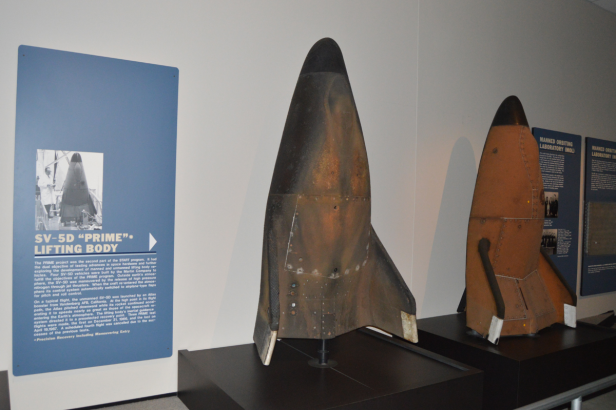
The Heavyweights
By the mid 1960s NASA engineers and pilots at the Flight Research Center had gained enough confidence in the lifting body through flights of the lightweight M2-F1 that the decision was made to construct a heavyweight metal version, the M2-F2, to conduct more extensive tests at higher speeds and altitudes. Improved control surfaces were incorporated with a single underbody flap, split upper-body flaps and outboard rudders on the vertical surfaces. The original plan had called for two M2-F2s to be built, but FRC managers decided to take the opportunity to test out a second design developed at NASA’s Langley Center, the HL-10. Where the M2 shape had a rounded half cone underside and flat top, the HL-10 featured a flat underside and curved upper surface featuring 3 fins. Both of the NASA ‘heavyweight’ lifting bodies would be rocket powered (using the venerable XR-11 engine first used on the X-1 two decades earlier) and air-launched from the FRC B-52s that were also used for the X-15 programme. Northrop won the contract to manufacture both vehicles and initial glide tests began during 1966.
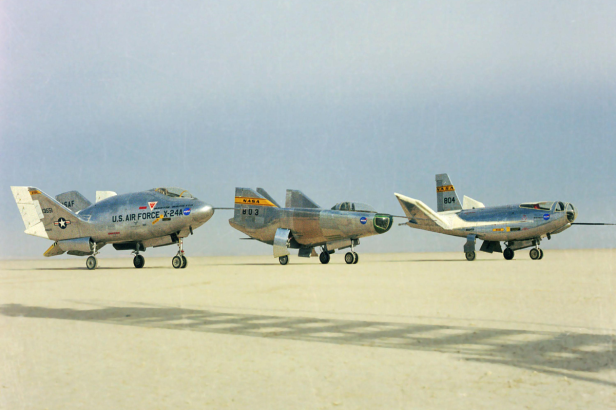
During March 1966, even as the PRIME tests continued, the Air Force also decided to move to a heavyweight piloted version of the SV-D shape under the Piloted Low-speed Tests (PILOT) program to complete START. Originally designated the SV-5P, the vehicle was again constructed by Martin Marietta and rolled out in August 1967 by which time the Air Force had assigned it the new designation X-24A. Static testing soon began at Edwards AFB followed by wind-tunnel testing at NASA Ames. As with the other heavyweight lifting bodies, the X-24A was powered by the XLR-11 rocket engine and was to be air-launched by the B-52 motherships. Unlike its PRIME predecessor the SV-5D, the X-24A featured a central fin for additional directional stability at low speeds, and moveable upper body flaps to complement the underbody ones. Rudders were included on the two outboard vertical surfaces.
Having flown the earlier M2-F1 Chuck Yeager, in his role as Commandant of the USAF Aerospace Research Pilot School at Edwards, was a keen supporter of the lifting body concept and was instrumental in suggesting that the X-24A should be accompanied by jet powered training versions to give his students more experience in the unusual vehicle. Martin Marietta used their own funds to construct two of the training vehicles, designated SV-5Js, powered by a single Pratt & Whitney J60-PW-1 engine with a ventral intake. Once completed, Martin Marietta approached the FRC and research pilot Milt Thompson to see if they would undertake test flights of the SV-5J. When FRC engineers calculated that the vehicle was woefully underpowered and recognised it would be dangerous to fly, NASA and Thompson declined. Undeterred, Martin Marietta then offered Thompson $20,000 to undertake a test flight on a private basis. As Dale Reed describes in his book Wingless Flight:
“Thompson offered to accept Martin’s $20,000 if he could get it airborne by simply bouncing the SV-5J a few inches into the air by running it across a two-by-four on the runway. Martin didn’t accept Thompson’s ‘Flight Plan’.”
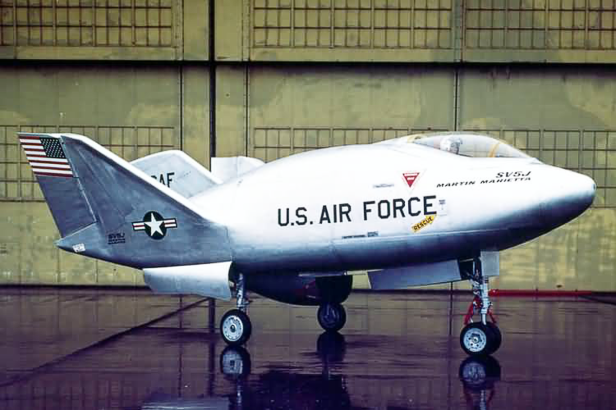
The final X-24A flight occurred on June 4th 1971, drawing the PILOT and START programmes to a close. The X-24A, while challenging to fly especially without the stability augmentation system engaged, had proved that the SV-5 shape could be piloted from supersonic speeds down to a controlled landing. When combined with the earlier PRIME results, the START programme had proven that an SV-5 derived lifting body could perform well across the entire flight envelope from near orbital speeds all the way down to a runway landing. But while the X-24A programme was now at an end, the vehicle itself was about to get a new lease of life.
A new breed of Lifting Body
Even as the X-24A was beginning its flight test programme, engineers at the FRC and Air Force were starting to think about a new breed of lifting bodies. The initial generation of heavyweights, the M2-F2/F3, HL-10 and X-24A, all had lift-to-drag ratios in the 1.2 – 1.4 range. In an effort to create better lift-to-drag characteristics, thus increasing range and cross-range during re-entry or hypersonic flight, new configurations were being considered. At NASA’s FRC, Dale Reed was experimenting with a design named Hyper III, a longer more slender shape than the previous lifting bodies, with a triangular planform and flat base that featured small horizontal ‘winglets’ at the rear. Testing showed that the Hyper III shape would have a lift-to-drag of nearer 3.0 during hypersonic flight. the disadvantage of the shape was that it would need small deployable wings to generate enough lift for landings at subsonic speeds. As he had with the M2, Reed set about building a scale model of the Hyper III to test various wing types during the final descent phase. With promising results in hand, the FRC moved forwards with a small programme to create a piloted prototype as they had with the M2-F1. Unfortunately Hyper III failed to gain traction with a NASA HQ currently managing Apollo and other large programmes.
Fortunately, at Wright Patterson AFB, a team at the Air Force’s Flight Dynamics Laboratory (FDL) led by engineer Alfred Draper had been thinking along broadly similar lines to Reed for some time. They had generated a number of configurations for hypersonic or space capable vehicles using the lifting body concept. One of their concepts, the FDL-8, had already formed the basis for the Lockheed STARClipper spaceplane design, later used as the starting point for Lockheed’s Space Shuttle proposals. Now Draper and the FDL saw the opportunity to modify the X-24A by adding additional airframe elements to create a new FDL-8 inspired lifting body. The configuration they came up with would require no deployable wings for approach and landing and had the huge advantage of being relatively inexpensive as it was using the existing X-24A airframe and many of its systems. Discussions between NASA FRC and the Air Force Flight Test Center led to an agreement to jointly fund and operate the new programme, designated the X-24B.
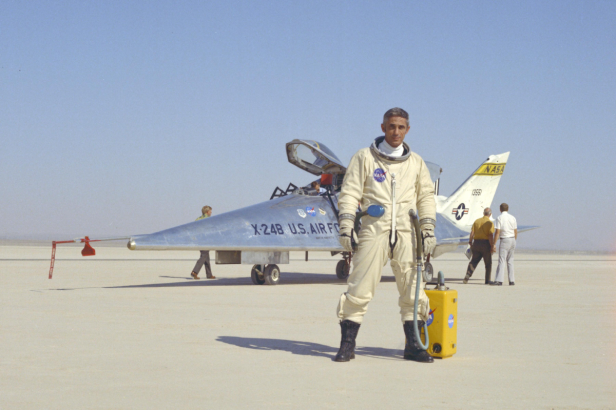
Over the next two years Manke and project pilot Michael Love took the X-24B to a maximum speed of Mach 1.75 and a maximum altitude of over 74,000 ft. Enthused by the vehicle’s superior handling (which Manke compared to that of contemporary fighter aircraft) and the X-24B’s proven ability to make accurate landings, a series of flights were planned to demonstrate its ability to make accurate landings on the main concrete runway at Edwards. Proving this was possible would go a long way towards settling arguments within NASA regarding the need to include extendable jet engines on the forthcoming Space Shuttle for approach and landing. On August 5th 1975 Manke brought the X-24B to a pinpoint runway landing from an altitude of 60,000 ft. When this ability was demonstrated again some weeks later by Love, the argument was settled. The jet engines could be deleted from the Shuttle Orbiter’s design saving valuable weight and freeing up more space for payload. Towards the end of the programme Manke and Love were joined by NASA research pilot Bill Dana and on September 3rd 1975 Dana made the final powered flight of the programme which was also the final flight by a piloted rocket plane at Edwards AFB bringing to a close an era of experimental flight research stretching back to the 1940s. Six more unpowered flights were made to familiarise three more pilots with the vehicle with the final lifting body flight taking place during November 1975 with NASA pilot Thomas McMurtry at the controls.
For a while it seemed that the X-24B would have a direct descendant as the Air Force and NASA examined the feasibility of producing an air-breathing hypersonic vehicle based on the FDL-8 configuration and the flight experience gained during the X-24B. Acting as a testbed for interchangeable scramjet prototypes the X-24C would be capable of speeds in the range of Mach 6-8, effectively picking up where the X-15A-2 had left off. The programme became known as the National Hypersonic Flight Research Facility (NHFRF) and design studies were undertaken by both Martin Marietta and the famed Lockheed Skunk Works. Unfortunately by 1977 rising costs associated with the programme led NASA to withdraw effectively killing the NHFRF. Rumours have persisted for many years that the X-24C programme was continued by the Air Force on a classified basis at Groom Lake, but as with so many supposed ‘black’ aircraft no definitive proof of this has surfaced.
Lifting Body lifeboats
One of the key advantages of the lifting body over a capsule is that it can perform ‘gentler’ lower G reentries to a large range of landing sites from each orbit. While the Air Force may have been thinking more in terms of lifting body derived weapons systems, designers at Martin Marietta were eager to find other uses for their SV-5 design and were quick to recognise that the lifting body’s advantages made it ideal as a quick response rescue vehicle capable of returning stranded or injured astronauts to terra firms quickly and safely. The resulting proposal became known as the National Orbital Rescue Service (NORS). Martin’s proposal met a cool reception from both NASA and the DoD, essentially the only two parties with a potential use for such a system. While NORS never reached a test or hardware stage, a very similar SV-5 derived vehicle did make it onto the silver screen in the 1969 film Marooned, an adaptation of an earlier novel by Martin Caidin.
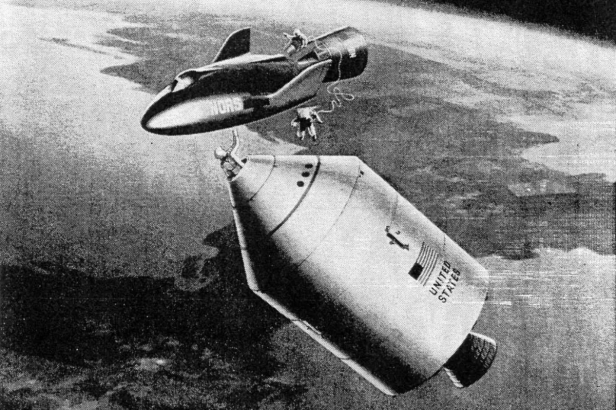
Given the amount of data available from the PRIME and PILOT programmes, the SV-5D shape was chosen for what was initially called the Assured Crew Return Vehicle (ACRV). During May 1995 Reed was able to test out radio controlled sub scale models of the vehicle as an initial proof of concept for the landing phase. With the basic concept approved NASA issued a contract to Scaled Composites in 1996 for the construction of three 80% scale atmospheric test vehicles, under the designation X-38. During 1997, the first two test vehicles were delivered to Dryden and began captive carry tests using the B-52 carrier aircraft. The first drop test was conducted in March 1998 but was only partially successful due to parafoil problems and issues with the landing skids. After further parafoil development and testing, the X-38 drop tests continued at Dryden with more promising results proving the autonomous landing system would work as designed. Flight testing continued for a number of years with one of the models being modified to represent the finalised orbital Crew Return Vehicle (CRV as the program was now known) configuration. At NASA Johnson, construction began on an orbital test vehicle, but as promising as the X-38 may have seemed, events elsewhere were about to lead to its demise.
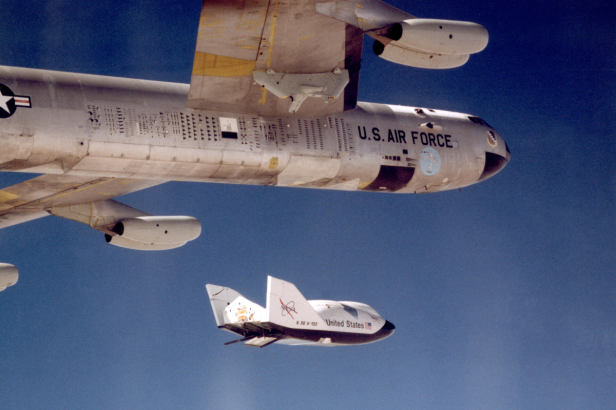
Author’s Notes
In describing the Air Force’s PRIME programme, I have referred to the test vehicle as the SV-5D, rather than the commonly used X-23A designation as this appears to have been retrospectively applied to the vehicle and was not in use during the operational phase of the programme.
I have also included the ASSET programme as part of the START. Some programme histories take this approach, others only include the PRIME and PILOT programmes, but for this article I chose the former approach as I felt the inclusion of ASSET had relevance to the wider Air Force initiatives around lifting reentry.
Finally, the sole X-24B now resides at the National Museum of the US Air Force at Wright Patterson AFB. It is accompanied by one of the unflown Martin Marietta SV-5J prototypes which has been modified to represent the original X-24A configuration. The museum also has the sole recovered SV-5D from the PRIME programme and a recovered ASSET test vehicle.
Sources
Wingless Flight: the Lifting Body Story – R. Dale Reed with Darlene Lister
The X-Planes X-1 to X-45 – Jay Miller
Space Shuttle: The History of the National Space Transportation System (The First 100 Missions) – Dennis R. Jenkins
Space Shuttle: An Illustrated History of US Winged Spacecraft – Melvyn Smith
Secret Projects: Military Space Technology – Bill Rose
Flight Testing at Edwards: Flight Test Engineers Stories 1946-1975 – Edited by Fred Stoliker, Bob Hoey & Johnny Armstrong
National Museum of the US Air Force website – Accessed 15th May 2017
NASA X-38 online factsheet – Accessed 16th May 2017
The Space Review: A Tale of two Martins – Accessed 16th May 2017
Encyclopedia Astronautica: ASSET – Accessed 15th May 2017
Encyclopedia Astronautica: LUNEX – Accessed 14th May 2017

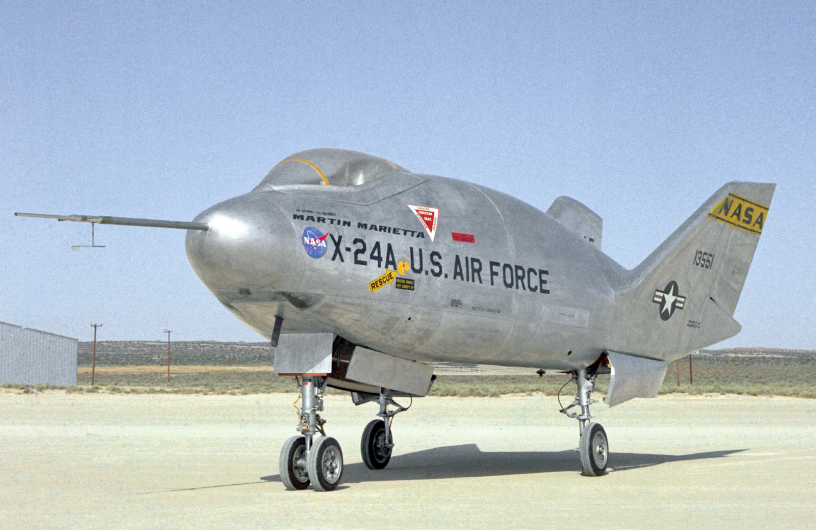
Ah NASA, the story of budget overruns and museum vehicles.
LikeLike
Well researched (and I have been enjoying the articles on your site). I always wondered about the connections among these. Perhaps you can do a part 2 which identifies any connection to the Soviet Bor vehicles which have suspiciously similar OMLs.
LikeLike
Hi, thanks for getting in touch.
I did take a look at the BOR vehicles in a previous post ( https://thehighfrontier.blog/2015/10/27/dream-chaser-dna-a-story-of-spaceplane-evolution/ ).
My own impression is that their designs were almost certainly influenced by the work done on NASA lifting bodies, especially the HL-10, but that the Soviet designers introduced significant refinements to this based on their own research. The result was that, once NASA was able to study the BOR-4 config in detail and recognise its advantages, this then became the basis for the Langley HL-20 which in turn led to Dream Chaser.
LikeLike